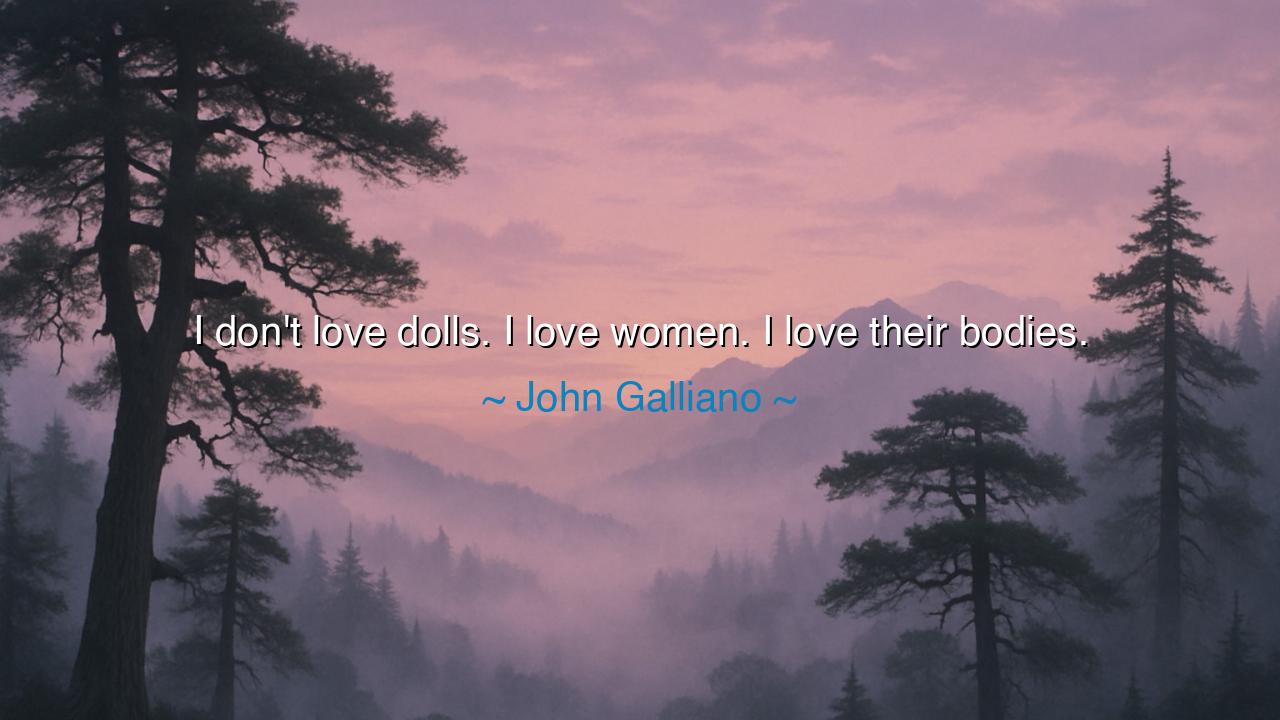
I don't love dolls. I love women. I love their bodies.






The words of John Galliano—“I don’t love dolls. I love women. I love their bodies”—burn with a fire that separates illusion from reality. In them we hear a rejection of the lifeless ideal, the artificial and unbreathing image that has too often been imposed upon womanhood. Galliano, a master of fashion, declares that his inspiration does not spring from hollow figures molded in silence, but from the living form of women—with all its curves, movements, and power. This is not the adoration of a statue, but the reverence for life itself.
The origin of such a saying must be traced to the age-old tension between representation and reality. Artists have long been accused of loving their muses not as people, but as objects—painted, sculpted, or dressed without breath or voice. The doll, in this sense, is a symbol of objectification, of a body reduced to perfection without spirit. Galliano insists that true artistry cannot be born from such emptiness. The woman, real and imperfect, full of strength and vulnerability, is the true fountain of creation. Her body is not a lifeless form to be possessed, but a living vessel that inspires.
This wisdom recalls the tale of Pygmalion, the sculptor of Cyprus. He carved a statue so beautiful that he fell in love with it, forsaking real women for cold marble. The gods took pity and gave his creation life, but the myth reminds us that to love the form without the spirit is folly. Galliano’s words turn this ancient story on its head: he proclaims that he does not seek statues, nor dolls, but living, breathing humanity. He honors the truth that beauty lies not in frozen perfection, but in motion, vitality, and reality.
We see this lesson again in the Renaissance, where artists like Leonardo da Vinci and Michelangelo studied not mannequins but real people—farmers, warriors, mothers, and children—to capture the divine in the human form. Their reverence for the body, with its imperfections and grandeur, gave birth to works that still stir the soul. They, like Galliano, understood that beauty is not born in lifeless molds but in flesh animated by spirit.
The meaning of Galliano’s words is not confined to fashion or art; it speaks to life itself. How often do people fall in love with dolls—with images, ideals, fantasies of what a partner, a friend, or even a life should be? Yet such attachments are brittle, for they lack truth. To embrace reality, with its unpredictability and imperfection, is far more challenging—but it is also the only path to real love, creativity, and joy. The woman, in all her humanity, represents the truth that life is not meant to be polished into lifeless perfection, but lived in its vibrant fullness.
The lesson, therefore, is clear: do not chase dolls, whether they be false ideals, hollow appearances, or lifeless images of perfection. Seek instead the reality of women, of people, of life as it is—breathing, flawed, and radiant. To love reality is to love deeply; to love illusions is to remain forever empty. In the same way, in your work, in your relationships, in your vision of yourself, turn away from the lifeless standards imposed upon you. Choose instead to honor the body, the spirit, the truth of what is alive.
And so, let this teaching be carried forward: to create, to live, to love, we must reject the doll and embrace the human. Honor the body as sacred, honor the person as whole, and honor reality as the true canvas of beauty. For only then do we rise beyond the hollow and into the eternal.






AAdministratorAdministrator
Welcome, honored guests. Please leave a comment, we will respond soon